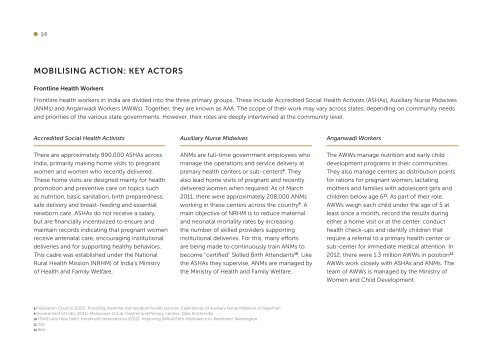UPCMP Process Document_Final-1-min
You also want an ePaper? Increase the reach of your titles
YUMPU automatically turns print PDFs into web optimized ePapers that Google loves.
14<br />
MOBILISING ACTION: KEY ACTORS<br />
Frontline Health Workers<br />
Frontline health workers in India are divided into the three primary groups. These include Accredited Social Health Activists (ASHAs), Auxiliary Nurse Midwives<br />
(ANMs) and Anganwadi Workers (AWWs). Together, they are known as AAA. The scope of their work may vary across states, depending on community needs<br />
and priorities of the various state governments. However, their roles are deeply intertwined at the community level.<br />
Accredited Social Health Activists<br />
Auxiliary Nurse Midwives<br />
Anganwadi Workers<br />
There are approximately 890,000 ASHAs across<br />
India, primarily making home visits to pregnant<br />
women and women who recently delivered.<br />
These home visits are designed mainly for health<br />
promotion and preventive care on topics such<br />
as nutrition, basic sanitation, birth preparedness,<br />
safe delivery and breast-feeding and essential<br />
newborn care. ASHAs do not receive a salary,<br />
but are financially incentivized to ensure and<br />
maintain records indicating that pregnant women<br />
receive antenatal care, encouraging institutional<br />
deliveries and for supporting healthy behaviors.<br />
This cadre was established under the National<br />
Rural Health Mission (NRHM) of India’s Ministry<br />
of Health and Family Welfare.<br />
ANMs are full-time government employees who<br />
manage the operations and service delivery at<br />
primary health centers or sub-centers 8 . They<br />
also lead home visits of pregnant and recently<br />
delivered women when required. As of March<br />
2011, there were approximately 208,000 ANMs<br />
working in these centers across the country 9 . A<br />
main objective of NRHM is to reduce maternal<br />
and neonatal mortality rates by increasing<br />
the number of skilled providers supporting<br />
institutional deliveries. For this, many efforts<br />
are being made to continuously train ANMs to<br />
become “certified” Skilled Birth Attendants 10 . Like<br />
the ASHAs they supervise, ANMs are managed by<br />
the Ministry of Health and Family Welfare.<br />
The AWWs manage nutrition and early child<br />
development programs in their communities.<br />
They also manage centers as distribution points<br />
for rations for pregnant women, lactating<br />
mothers and families with adolescent girls and<br />
children below age 6 11 . As part of their role,<br />
AWWs weigh each child under the age of 5 at<br />
least once a month, record the results during<br />
either a home visit or at the center, conduct<br />
health check-ups and identify children that<br />
require a referral to a primary health center or<br />
sub-center for immediate medical attention. In<br />
2012, there were 1.3 million AWWs in position 12 .<br />
AWWs work closely with ASHAs and ANMs. The<br />
team of AWWs is managed by the Ministry of<br />
Women and Child Development.<br />
8 Population Council (2012). Providing maternal and newborn health services: Experiences of Auxiliary Nurse Midwives in Rajasthan.<br />
9 Government of India (2011). Manpower at Sub-Centres and Primary Centres. Data Portal India.<br />
10 USAID and New Delhi: Intrahealth International (2012). Improving Skilled Birth Attendance in Jharkhand. Washington.<br />
11 Ibid.<br />
12 Ibid.


